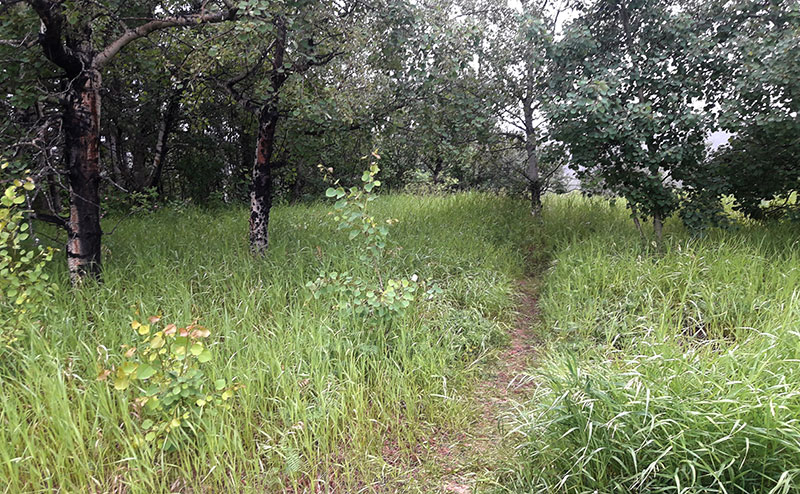
Naturalization research projects conducted by the City of Edmonton in partnership with the University of Alberta and MacEwan University.
The City of Edmonton has partnered to conduct several research projects in naturalized areas.
In spring 2017, Dr. Karen Christensen-Dalsgaard of MacEwan University partnered with the City of Edmonton on a 5-year research project with the purpose of improving the growth and survival of woody species in the Edmonton urban area.
The MacEwan research team is continuing work on 15 experimental plots that were established by the Anne Naeth lab from the University of Alberta in 2014.
Learn the history of the 2014 University of Alberta and City of Edmonton partnership research.
Research Project Objectives
Research Plots
The project will focus on the health and competitive interactions of the plants during the establishment phase. Further, the MacEwan team will visit additional naturalization sites to monitor survival of recently planted wooden seedlings in selected urban greenspaces. Several roadway and industrial naturalization areas are included.
In addition, the team will use dendrochronological techniques (also known as tree-ring dating) on tree cookies from mature trees provided by the City to study how long-term environmental stressors affect the growth of trees in Edmonton’s urban forest.
Research Plot Locations
Fifteen existing research plots located at 5 different locations will be included in MacEwan University’s 5-year extension of the study. These include:
- Lendrum research site
- 91 Street research site
- Terwillegar/Whitemud Interchange research site
- Smith research site
- Blackmud research site
Results from the experimental sites will be compared to woody plant survival at seven non-experimental naturalization sites across the city. These sites will be visited to provide survival data for a period corresponding to that of the research sites, and will include the following:
Root for Trees Volunteer Planting Sites
Naturalized sites planted with native tree and shrub species by volunteers:
- Pylypow Industrial NAT 1
- Pylypow Industrial NAT 2
- Satoo NAT
Roadway Operational Planting Sites
Naturalized sites planted with native tree and shrub species by professional tree planters:
- Bergman NAT 1
- Bergman NAT 3
- Newton NAT
- Montrose NAT
Trunk growth correlates with growth of the crown, and crown health, size, and density are important determining factors for the quality of ecosystem services provided by urban trees.
Led by Dr. Christensen-Dalsgaard, the MacEwan group will perform dendrochronological investigations on tree cookies provided by the City to study the historical response of urban trees to fluctuations in compounded environmental stressors. These will include drought, the impact of winter conditions, and mechanical stress.
Dendrochronology
Dendrochronology (or tree-ring dating) is the scientific method of dating tree rings (also called growth rings) to the exact year they were formed in order to analyze atmospheric conditions during different periods in history.
In 2014, Dr. M Anne Naeth of the University of Alberta, Department of Renewable Resources and the City of Edmonton partnered in a joint research project on naturalized areas. The research was focused on the effects of naturalization on living and non-living habitats.
The City of Edmonton is supportive of research and this project is the first of its kind in Edmonton.
We are pleased to share the results of the research:
- Urban Naturalization: An Approach Towards Sustainable Cities
- The Master's Thesis by Jaime Aguilar Rojas
Where are the Research Sites Located?
- Lendrum
- Strathcona Industrial Park, at 91 Street and Whitemud Drive
- Booster Juice Recreation Centre in Terwillegar
- Smith Crossing near 23 Avenue
- Skyrattler near Blackmud Creek Cliff site
- Bulyea Heights near Whitemud and Terwillegar Drive Interchange
Planting Plots
Each research site has a total area of 300m² divided into 16 plots of 10 x 10 m areas with 3 replicates of each treatment. Six sites had the same native species planted including white spruce, aspen, rose, snowberry and buffalo berry, amongst several other species which are native to Alberta.
At the Booster Juice Recreation Centre in Terwillegar, the exception is the unique plant material used. This site was planted with over 25 species of flowering wildflowers; for a total of almost 2000 units of native forbs and wildflowers. Some of the species include wild strawberry, white prairie aster, meadow blazing star, and wild mint, amongst others.
Treatment Design
Each site, including the Booster Juice Recreation Centre in Terwillegar, has the following treatments: tillage, herbicide, compost, topsoil, double topsoil, double compost, and several other combinations of these treatments in conjunction with others, for example: tillage plus herbicide, tillage plus compost.
See Treatment Design
Naturalization Initiatives
Naturalization has been occurring in Edmonton for nearly three decades! Learn about the naturalization projects that are being done in the city.
Contact Us
311 Contact Centre
Phone 311 | Outside Edmonton and Video Relay Service (VRS): 780-442-5311 | TTY 711

